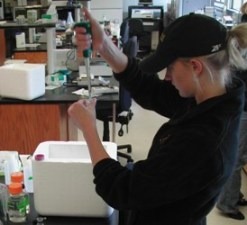Kelly Rozenboom
Spectroscopic Characterization of the Active Site of γ-Glutamylcysteine Synthetase
Chemistry, Dr. Kelly
About My Research:
Glutathione plays an important biological role in detoxification in nearly all eukaryotes. It has recently become of great interest due to its high abundance in cancer cells and its ability to slow or block chemotherapeutic treatments. Therefore, by slowing or blocking glutathione synthesis, cancer cells may become more susceptible to these therapeutic techniques. In Dr. Brenda Kelly’s lab, protein conformational changes and their effects on activity is a particular study of interest, and this summer I am investigating how to “fool” the enzyme γ-Glutamylcysteine synthetase (γ-GCS), which catalyzes the first step in the synthesis of glutathione. After purifying γ-GCS from E. coli, I am using UV/Vis spectroscopy (which measures changes in light absorption from chemicals) to examine the effects of various substrate analogs on the activity of γ-GCS. This way we can identify structures and small molecules that might take the place of its natural substrate, thus altering its enzymatic activity. I will also be using fluorescence spectroscopy in order to probe potential changes in the enzyme’s molecular shape upon binding of the analogs.
This research was supported by the 2007 Greater Gustavus Summer Research Fund.
Professional Abstract:
Glutathione plays an important biological role in detoxication in nearly all eukaryotes. Recently, it has been implicated in chemotherapeutic resistance due to its high abundance in many cancer cells and its ability to slow or block chemotherapeutic effects. By inhibiting glutathione synthesis, cancer cells may become more susceptible to some therapeutic techniques. The enzyme, γ-glutamylcysteine synthetase (γ-GCS) catalyzes the first step in the synthesis of glutathione. In the present study, UV/Vis spectroscopy was used to identify substrate analogs that alter the activity of γ-GCS, while fluorescence spectroscopy was used to probe the effect of these analogs on the binding of natural substrates. These studies suggest that the enzyme active site contains two distinct binding sites that may be filled with a cysteine-like molecule. To further investigate the metal-binding sites of γ-GCS, preliminary titration studies with cobalt were performed for future study of the enzyme using NMR.
Links:
- Learn more about the Department of Chemistry
- Go to the student's Faculty Research Advisor